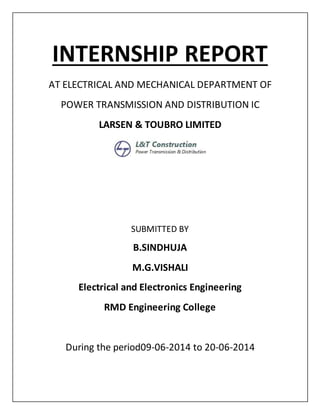This document summarizes an internship report submitted by two interns at the Electrical and Mechanical Department of Power Transmission and Distribution IC of Larsen & Toubro Limited. It provides details of their internship, which involved reviewing specifications for the Bangalore Metro Rail Corporation Limited project. It describes the scope of work for electrification of metro rail stations, including earthing philosophy, load details, cable sizing, and distribution transformer sizing. It also discusses metro rail terminology and traction systems used in various Indian metro projects.



















































![So far from these equations
Vph
2
= (VmcosQ +
Ist RmVm
VPh
)2
+ (𝑉𝑚 𝑠𝑖𝑛𝑄 +
𝐼𝑆 𝑉𝑚(𝑋 𝑚 + 𝑋𝑠𝑜
𝑉𝑃ℎ
+ 𝐼 𝑚1 𝑋𝑠𝑜
(𝑉𝑃ℎ − 𝑉𝑏)
𝑉𝑏
)2
RESULT:
Using the rating of transformer KVA thermal loading on transformer during motor starting ,
voltage available at motor during motor starting, voltage available at bus during motor starting,
the transformer size is selected.
Electrical Calculations – Lighting Calculations
The lighting calculations has been carried out based on the outline design requirements from
BMRCL, Design basis reports and design review discussions with general consultants. DIALUX
software has been used for lighting calculations. The lighting fixtures have been selected to suit
the architectural ceiling plan.
General inputs:
Height of the room in m
Mounted height m
Maintenance factor
We determine the following
The minimum lux in the corners 𝐸 𝑚𝑖𝑛 [lx]
The maximum lux which is the concentrated intensity of light 𝐸 𝑚𝑎𝑥[lx]
The average lux in the room 𝐸 𝑎𝑣𝑔 [lx]
Reflection factor 𝜌[%]
Utilization factor u0
For the surfaces: work plane, floor, ceiling and walls
From the determined parameters we decide the luminaries’ parts list.](https://image.slidesharecdn.com/355a7a70-6e2c-4251-be9d-c2f3dbc653a7-160910040522/85/INTERNSHIP-REPORT-FINAL-52-320.jpg)


